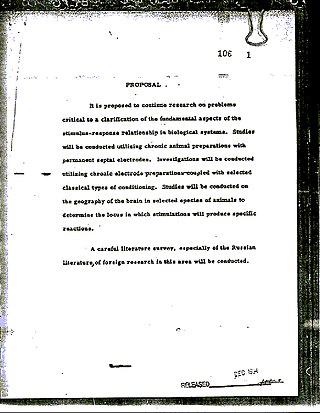
Project MKUltra was an illegal human experimentation program designed and undertaken by the U.S. Central Intelligence Agency (CIA), intended to develop procedures and identify drugs that could be used in interrogations to weaken individuals and force confessions through brainwashing and psychological torture. It began in 1953 and was halted in 1973. MKUltra used numerous methods to manipulate its subjects' mental states and brain functions, such as the covert administration of high doses of psychoactive drugs and other chemicals, electroshocks, hypnosis, sensory deprivation, isolation, and verbal and sexual abuse, in addition to other forms of torture.

Gerald Vincent Bull was a Canadian engineer who developed long-range artillery. He moved from project to project in his quest to economically launch a satellite using a huge artillery piece, to which end he designed the Project Babylon "supergun" for Saddam Hussein's government in Iraq.
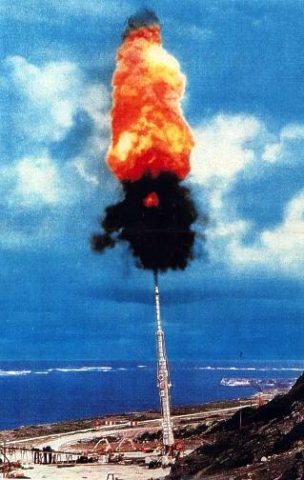
Project HARP, short for High Altitude Research Project, was a joint venture of the United States Department of Defense and Canada's Department of National Defence created with the goal of studying ballistics of re-entry vehicles and collecting upper atmospheric data for research. Unlike conventional space launching methods that rely on rockets, HARP instead used very large guns to fire projectiles into the atmosphere at extremely high speeds.

The GC-45 is a 155 mm howitzer designed by Gerald Bull's Space Research Corporation (SRC) in the 1970s. Versions were produced by a number of companies during the 1980s, notably in Austria and South Africa.
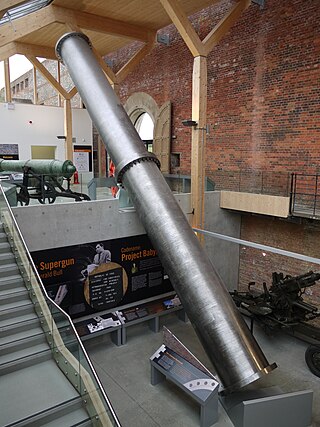
Project Babylon was a space gun project commissioned by then Iraqi president Saddam Hussein. It involved building a series of "superguns". The design was based on research from the 1960s Project HARP led by the Canadian artillery expert Gerald Bull. There were most likely four different devices in the program.

The formal definition of large-calibre artillery used by the United Nations Register of Conventional Arms (UNROCA) is "guns, howitzers, artillery pieces, combining the characteristics of a gun, howitzer, mortar, or multiple-launch rocket system, capable of engaging surface targets by delivering primarily indirect fire, with a calibre of 75 millimetres and above". This definition, shared by the Arms Trade Treaty and the Treaty on Conventional Armed Forces in Europe, is derived from a definition in United Nations General Assembly Resolution 46/36L, which set a threshold of 100mm. Several grammatical changes were made to that latter in 1992 and the threshold was lowered in 2003 to yield the current definition, as endorsed by UN General Assembly Resolution 58/54.
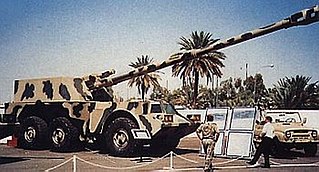
Al-Fao is a self-propelled artillery system designed for the former Iraqi Army by the late Canadian weapons engineer, Gerald Bull. It is one of the world's most powerful artillery pieces, with a caliber of 210 mm (8.3 in) and a range of 56 km (35 mi). The Al-Fao system weighs 48 tons and can drive on roads with a top speed of about 72 km/h (45 mph). Its gun is claimed to be able to fire four 109 kg (240 lb) rounds a minute. The projectiles could be filled with chemical weapons such as sarin, mustard gas or phosgene, or with conventional high explosives.

The Paris Gun was the name given to a type of German long-range siege gun, several of which were used to bombard Paris during World War I. They were in service from March to August 1918. When the guns were first employed, Parisians believed they had been bombed by a high-altitude Zeppelin, as the sound of neither an airplane nor a gun could be heard. They were the largest pieces of artillery used during the war by barrel length, and qualify under the (later) formal definition of large-calibre artillery. Also called the "Kaiser Wilhelm Geschütz", they were often confused with Big Bertha, the German howitzer used against Belgian forts in the Battle of Liège in 1914; indeed, the French called them by this name as well. They were also confused with the smaller "Langer Max" cannon, from which they were derived; although the famous Krupp-family artillery makers produced all these guns, the resemblance ended there.
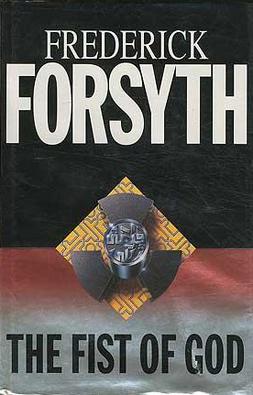
The Fist of God is a 1994 suspense novel by British writer Frederick Forsyth, with a fictitious retelling of the Iraqi Project Babylon and the resulting "supergun".

A space gun, sometimes called a Verne gun because of its appearance in From the Earth to the Moon by Jules Verne, is a method of launching an object into space using a large gun- or cannon-like structure. Space guns could thus potentially provide a method of non-rocket spacelaunch. It has been conjectured that space guns could place satellites into Earth's orbit, and could also launch spacecraft beyond Earth's gravitational pull and into other parts of the Solar System by exceeding Earth's escape velocity of about 11.20 km/s. However, these speeds are too far into the hypersonic range for most practical propulsion systems and also would cause most objects to burn up due to aerodynamic heating or be torn apart by aerodynamic drag. Therefore, a more likely future use of space guns would be to launch objects into Low Earth orbit, at which point attached rockets could be fired or the objects could be "collected" by maneuverable orbiting satellites.
The Arms-to-Iraq affair concerned the uncovering of the government-endorsed sale of arms by British companies to Iraq, then under the rule of Saddam Hussein. The scandal contributed to the growing dissatisfaction with the Conservative government of John Major and the atmosphere of sleaze that contributed to the electoral landslide for Tony Blair's Labour Party at the 1997 general election. The whole affair also highlighted the weakness of the constitutional convention of individual ministerial accountability, leading to its codification as the Ministerial Code by the Blair Government.
John Hunter is an American projectile researcher, who developed the 1994 "supergun" Super High Altitude Research Project (SHARP) at the Lawrence Livermore National Laboratory. The ultimate aim of his research is to shoot payloads into space, at less than one tenth of the cost of unmanned rockets. John Hunter was the director of Quicklaunch until 2012 and currently runs a startup called Green Launch that is developing a light gas gun concept
The Scott Report was a judicial inquiry commissioned in 1992 after reports surfaced of previously restricted arms sales to Iraq in the 1980s by British companies. The report was conducted by Sir Richard Scott, then a Lord Justice of Appeal. It was published in 1996. Much of the report was classified as secret.
Space Research Corporation was a corporation founded by Gerald Bull, after the budget for his research at Project HARP for the United States and Canadian federal governments was cut in 1967, in order to commercialize the technology of long-range artillery. Project HARP's assets were then given to the newly formed SRC. The main facility of SRC was 6,000 acres (2,400 ha), straddling the Canada–United States border between Highwater, Quebec, and Jay, Vermont. Affiliated companies included: SRCQ ; Shefford Electronics Corp ; SRCI; Paragon; PRB ; and SRCB.
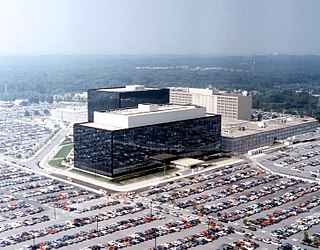
The Five Eyes (FVEY) is an intelligence alliance comprising Australia, Canada, New Zealand, the United Kingdom, and the United States. These countries are parties to the multilateral UKUSA Agreement, a treaty for joint cooperation in signals intelligence. Informally, Five Eyes can also refer to the group of intelligence agencies by these countries.
The Restricted Enforcement Unit (REU) is an expert-level committee set up in 1987 by the British government to control exports of military technology from the United Kingdom, in particular the illegal export or trade of conventional weaponry and weapons of mass destruction not licensed for export by the Department of Trade and Industry.
In the United Kingdom there were direct sales to both sides in the Iran–Iraq War. With an embargo in effect various companies also supplied Iraq and Iran by shipping materials through third-party countries and from those countries to the belligerents. While some of this exporting was legal, permitted or tolerated by parliament, Iraqi clandestine procurement operations were especially active in Britain.

Doomsday Gun is a 1994 television film produced by HBO, dramatizing the life of Canadian supergun designer Dr. Gerald Bull and his involvement in Project Babylon, Saddam Hussein's plan to build a supergun with a range of over 500 miles (800 km).

Mossad is the national intelligence agency of Israel. It is one of the main entities in the Israeli Intelligence Community, along with Aman and Shin Bet.

The Secret Intelligence Service (SIS), commonly known as MI6, is the foreign intelligence service of the United Kingdom, tasked mainly with the covert overseas collection and analysis of human intelligence in support of the UK's national security. SIS is one of the British intelligence agencies and the Chief of the Secret Intelligence Service ("C") is directly accountable to the Foreign Secretary.














